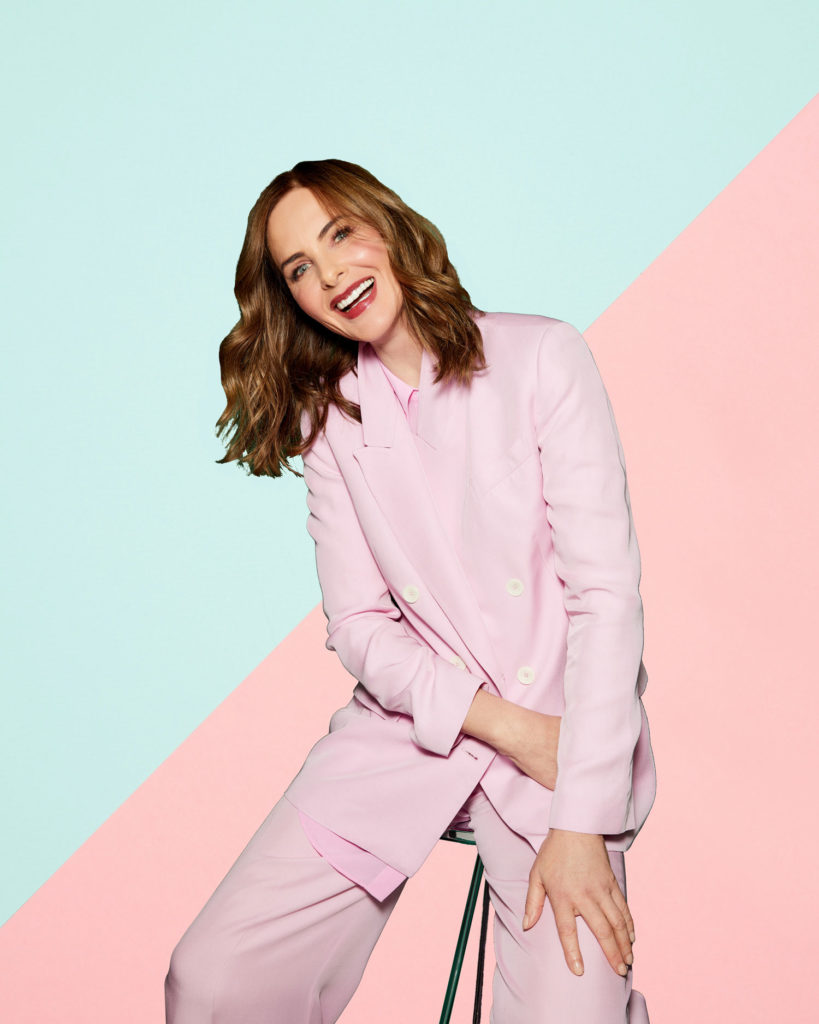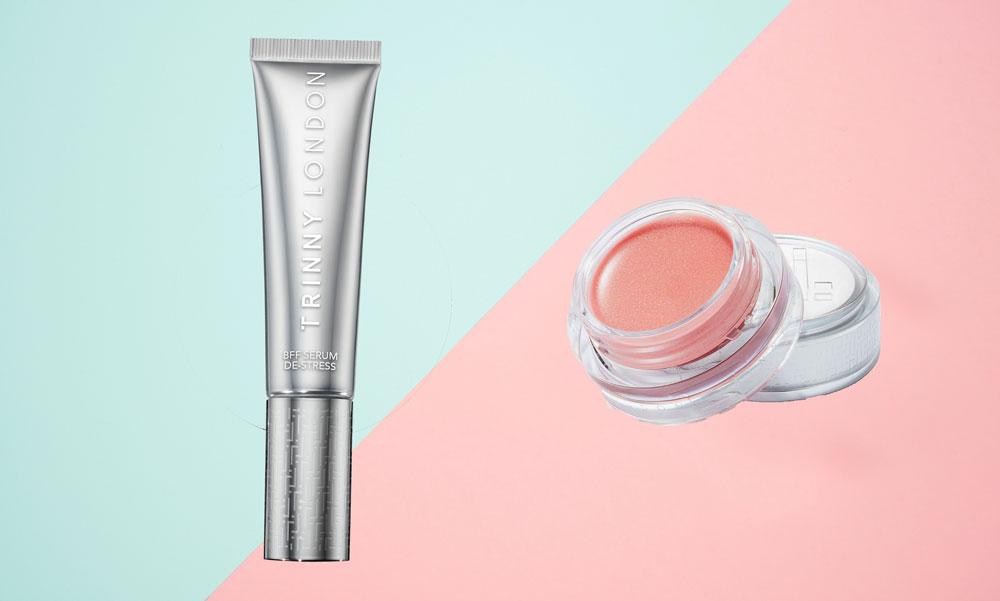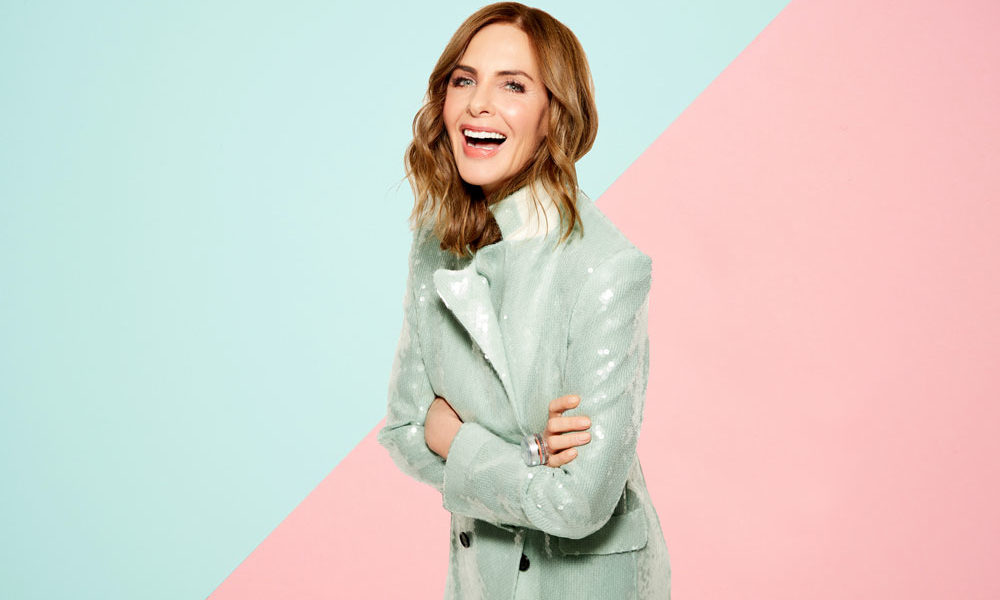As I enter the Crown Suite in the Royal York hotel, Trinny Woodall walks straight toward me. She’s in Toronto to promote her skin and makeup line, Trinny London. Usually at these kinds of celeb/PR meet-and-greets, the handlers bring the civilian journalist to the talent. But Trinny’s direct style – that’s how she delivered her advice from the hit BBC show What Not To Wear from the early naughts – is warm and inviting just like her two-hand handshake. We’re to sit comfortably on the same chic couch, each of us with one leg scooched underneath, as we chat like old friends.
I was a fan of her show, books and social media before I met her in real life, but now I know we were meant to be good friends, even if it was just for an hour – the length of my interview time slot. You could say I was part of the Trinny Tribe, her allegiance of fans and followers. I have a handful of her and Susannah Constantine’s (her WNTW co-host) books, which I even brought with me, in hopes of an autograph.
She did better than that. She was the most likeable and frankest interview I’ve ever had – and I’ve had the opportunity to interview some great people (ahem, #namedrop Meghan Markle). I’m also a fan of Trinny’s personal style. When I had met Stacy London a few years ago (host of the popular American spin-off of Trinny’s show on TLC) , she said that everyone thinks their style is “classic with an edge.” So I know not to describe Trinny’s style to her that way.
Good personal style is about comfort and feeling good
FLEETSTREET: I appreciate your approach to style because I feel like it’s feminine, but not performative. And it’s about comfort, yet still looking good. I like that you don’t dress for anyone.
Trinny Woodall: I dress for myself. You are the first person, out of the thousands of interviews I’ve done, who’s described my style exactly as I see it. I’d never wear a killer-high heel and feel uncomfortable. No, but I want to feel glamorous. I do that juxtaposition, and feel I got it.
FS: Yes, I love that. How do you achieve that?
TW: I’ve been through the eras where I would do painful dressing because I was doing it for other people. I was doing it to have competence. I was doing it to impress a guy. I was doing it to fit into the workplace. I dressed very much like a man; androgynous when I used to trade commodities. In my 20s, I would be in high heels and crazy outfits. I would put things on to try to be the person I wanted to be but not how I felt. And then, in my 30s, I started writing books and did TV, so I followed advice. Through that whole “public” period, I knew the rules for my body shape and colours. And so, in my 40s, it all came together. I then knew what I would reject and never wear. Every 10 years, you reframe who you are as a person. And you think, What do I suit? Who do I want to be? Am I channeling what I want to what I feel I am inside? This is the closest I’ve been in my life where my inside and my outside are close – there’s not even an air bubble between them. There were many moments of that “20s-imposter syndrome.” In my 30s it was what I felt people expected of me. And now, in my 50s, I don’t worry what people think. And it’s really such a freedom.
FS: How does that apply to your approach to beauty?
TW: I’ve always had an obsession with skincare because I had really bad skin when I was younger. So makeup for me was always to cover up. Makeup was the first thing I did for Trinny London. I did so many women’s makeovers, the first thing they would notice is their makeup. Knowing their makeup felt dated, they didn’t know what to do or where to start.
FS: So, how do you apply that level of style and comfort in your own beauty line?
TW: It should all be easy. When I launched Trinny London, I felt a lot of women had the paradox of choice. We go to a department store, we see 20 red lipsticks, what one am I!? Or, it’s tough. You see videos of makeup artists spending two hours doing makeup, and you think, when am I going to do that? Then you look at yourself in the morning, and you think, I’d like to do a bit more, but I don’t know where to start.
I wanted to make [my makeup line to be] easy. I wanted to say, here’s your palette. So, it’s that transition between “where do I start?” to “Somebody’s already done the curation for me.” Like, 75% of people who use Trinny London do Match2Me [a service]. And, then, it was about “how can I just literally do it with my fingers?” That’s why I do my make-up videos, where I literally put it on with my finger. I’ll use one colour everywhere. And it can be done in five minutes, and I feel I’ve transitioned between feeling tired and exhausted to feeling full of energy, with some colour on my face. I want women to think it’s so accessible.
Kylie Jenner ASMR & Sound Baths: Is sound a meditation cheat code?
From What Not To Wear to style and beauty influencer
FS: Let’s talk about trends. How has style changed since the show? From a culture prescriptive, fashion tips, it seems, have gone away. We’re embracing everyone’s expression, their body types and what they want to wear.
TW: There are definitely still rules. Little rules that make such a difference. As we go down the path of life, we lose a bit of our posture, our bone structure softens. You need more structure, because more structure will frame everything and make it crisper. Before I would have bought into body shape trends, like never were a turtleneck if you have big boobs. I say, yes you can. You might wear a jacket over it. You might make sure you’ve got a good bra on. You might have a bag with a strap that goes across the body because big boobs deserve separation, so you don’t have a uniboob. So there are still rules. But no shaming. I don’t think that we ever shamed in our books, or on What Not To Wear. Be proud of your boobs. Even then, it was not about shaming. It was that forthrightness at the beginning of the show. It was an emotional journey for those women.

Trinny London and her $2 billion beauty empire
FS: I want to ask you about being an entrepreneur. So much of an entrepreneur’s journey is finding something that they themselves need, and realizing that they’re not the only one. How much of your business still is about you and your needs?
TW: What I’ve done is to meet women’s needs. The formulations I have created, and the formulation for skincare I’ve created, along with what I know, I have a very high benchmark because I’ve tried thousands of products. So to me, I didn’t want to do a drugstore brand that dilutes active ingredients for skincare. I want to say that this is best-in-class skincare. This has formulations, which are powerful and strong.
There are what I call “best actor” and “supporting actors” in the formulations. Retinols don‘t like other ingredients very much. They dilute the ability for [retinol] to work. And hyaluronic acid loves a friend.
It’s about creating things I know will help other women’s skin. We’re still in a stage, five years in, where I create things I know will help somebody. And, we hear, also, what they might say they would like. We have a lot of data on women, because we do Match2Me in skincare. So, I know that 30% of the women who look at our products have sensitive skin. But there are no serums for sensitive skin that actively help reduce sensitivity. The order in which I create things is now affected by the feedback I get from women about how they’re feeling about their skin.
FS: But, it all started with you having a need while travelling, right?
TW: I came up with the idea when I was travelling. On a Monday, I would leave London and come back on a Friday. I would blend all these formulations and put them in Muji pots. The idea of stackable portable beauty definitely came from that. But the context of the ingredients of formulations came from women just saying, “Shall I do my eyes first, then put all my foundation on?” I just thought, “How can I find a solution that makes it easier for women?”
When I look at all my products, they are either a “cool,” a “cool neutral,” a “neutral,” a “neutral warm” or a “warm.” They have a very specific palette of what they suit.
How Rihanna’s choreographer Tanisha Scott helped me get over my dance-phobia.

Dealing with stress and skin issues
FS: Which product most represents you? And then the second half of this question is: What product most represents your customer?
TW: The product probably most represents me is BFF De-Stress, because De-Stress was a skincare makeup hybrid. I formulated and released it just before lockdown, but we had to test it during lockdown. It’s a transformative product, which is me. I like to transform. And it answers a problem which is stress. I always knew, from speaking to a ton of facialists and functional medicine doctors, about the effects of stress on skin, the effects of too much cortisol. The stress releasing hormone sits on your epidermis, it dries out your skin. It’s like that panting dog fear moment. And it ages your skin. When we make our hybrids, we start with the problem we want to solve. We want to take stress away from women’s skin. We want to plump it. We want to give it coverage that is radiant, not matte. Not shiny, but doesn’t feel heavy coverage but covers a lot to ask for.
FS: And for your customer?
TW: And for our customer, the Sheer Shimmers are something we sell so much of. They are lip-to-cheek, but people can put them everywhere. And we sell a lot of Miracle Blur. It is the thing we’re probably most known for, in terms of it’s very easy to apply, fills in lines and has a universal shade. We sell one every 20 seconds.
FS: What’s the best advice you’ve ever received?
TW: That 99% of everything you worry about never happens.
FS: It’s true. Or, it won’t matter in like six months or whatever. What are your must haves for traveling in style and comfort? And just for not “what to wear” sake, what would you tell women not to do when it comes to beauty?
TW: When you put on your base, don’t put it on where your skin is best, first. Because when you put it where your skin is best, first, you put quite a lot of [foundation] on, and then you think you need to put even more on where your skin doesn’t feel as good. Whereas, if you just cover with a thin layer first – on a red nose or on your chin if you have rosacea – then you realize how little you need elsewhere.
And I think every woman should wear blusher. Some women have grown up in an era where it was all about bronzer, so they never learned how to do blush. But blusher is the most natural, beautiful way [to do makeup]. It just makes skin come alive more than bronzer would.
Ballerina Kylie Jefferson talks about finding and building her strength.
A note for Canadian women
FS: Anything else you want to share with FLEETSTREET?
TW: I have two sisters and a brother who are Canadian. And when I look at Canadians, there’s still a bit of a tall poppy syndrome here – that sense of don’t stand out too much. It’s a kind of neatness but not eccentricity. And there are those who say, when I’m 60, I will wear purple. It’s that sense that I won’t care anymore. So, I would ask Canadian women to not wait until an age, but think who we ought to be today and question why they’re scared? Why wait till then? Why wait until later?
We had some people for lunch, and they were all very affluent, lovely Canadian women. Some of them never double clean their skin. You’re doing it with FLEETSTREET, educating people about the importance of skincare and the importance of inside-outside health. I’m obsessed with reducing inflammation in the body. I think the more you feel educated, the more you think, what would I like to do that I’m not doing? I think women should ask themselves: “What would I like to do that I’m not doing?” And, “What’s stopping me doing it?” Whether that’s a job, leaving a partner, wearing bright colours, learning to do makeup – just challenge yourself.

